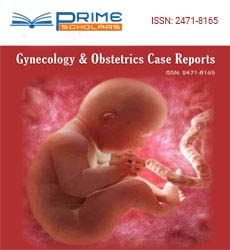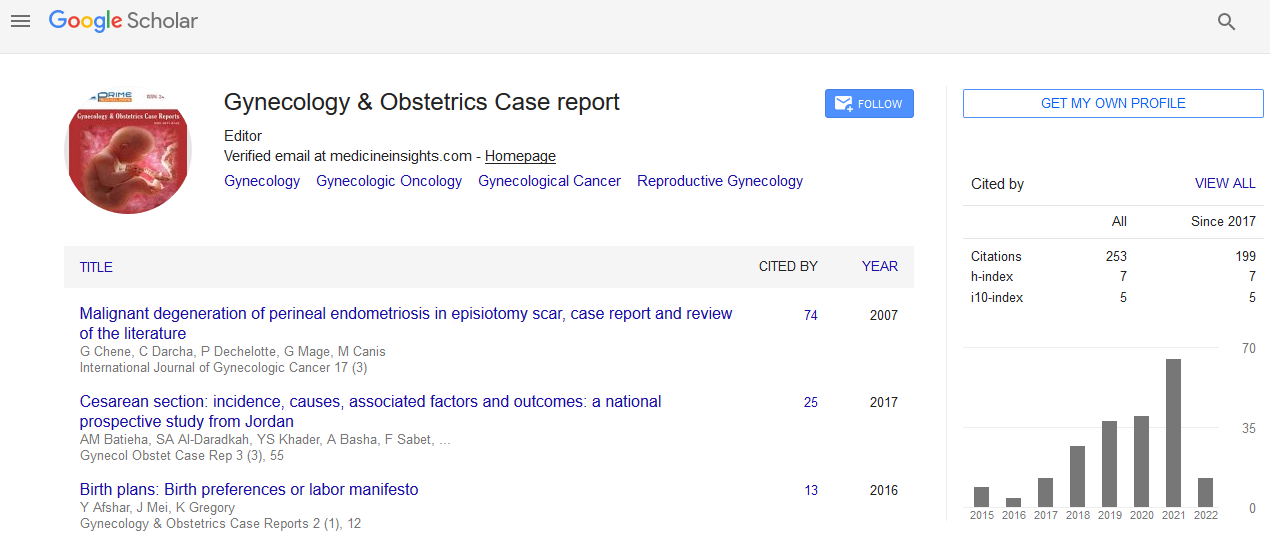Short Communication - (2025) Volume 11, Issue 2
Fertility Preservation in Women with Gynecologic Disorders: Challenges and Solutions
Delilah Josephine*
Department of Preventive Medicine and Public Health, University of Granada, 18071 Granada, Spain
*Correspondence:
Delilah Josephine, Department of Preventive Medicine and Public Health, University of Granada, 18071 Granada,
Spain,
Email:
Received: 24-Feb-2025
Editor assigned: 26-Feb-2025
Reviewed: 10-Mar-2025
Revised: 17-Mar-2025
Published:
24-Mar-2025
INTRODUCTION
Fertility preservation has become an essential consideration in the management of gynecologic disorders, especially as advancements in medicine have made it increasingly possible for women to maintain their reproductive potential despite medical challenges. Many gynecologic conditions, both benign and malignant, can significantly impact a womanâ??s fertility, either through direct effects on the reproductive organs or as a result of the treatment modalities employed. Consequently, addressing fertility preservation proactively is crucial for safeguarding the future reproductive options and quality of life for affected individuals [1].
One of the most significant challenges in this field is the impact of gynecologic cancers on fertility. Cancers such as cervical, ovarian and endometrial cancer often necessitate aggressive treatments like surgery, chemotherapy and radiation, which can impair or eliminate reproductive function. For instance, radical hysterectomy and bilateral oophorectomy, commonly used in managing these cancers, directly lead to infertility. Chemotherapy and radiation can also cause ovarian failure due to their gonadotoxic effects. In younger women diagnosed with early-stage disease, the possibility of fertility-sparing surgery is often considered; however, such approaches require meticulous patient selection and may carry a risk of recurrence [2].
DESCRIPTION
Even benign gynecologic disorders can compromise fertility. Conditions such as endometriosis, uterine fibroids and congenital uterine anomalies can negatively affect ovulation, fertilization and implantation. Endometriosis, for example, is associated with inflammatory changes and anatomical distortions that can hinder the function of the ovaries, fallopian tubes and uterus. Surgical treatment of endometriosis may also inadvertently damage ovarian reserve. Similarly, fibroids can distort the uterine cavity or alter blood flow, reducing the chances of successful implantation and increasing the risk of miscarriage. Treatment approaches for benign conditions must therefore be carefully tailored to preserve fertility whenever possible, often requiring a multidisciplinary team including gynecologists, reproductive endocrinologists and fertility specialists [3].
Another considerable challenge is the timely identification of women at risk of infertility due to their medical condition or its treatment. Many patients are unaware of the fertility risks associated with their diagnosis or may not receive adequate counseling before undergoing treatment. Delays in referral to fertility specialists can lead to missed opportunities for effective preservation strategies, especially when cancer treatment must begin urgently. Raising awareness among healthcare providers and integrating fertility counseling into standard treatment protocols is a key step toward improving outcomes. Psychosocial factors also play a role in the complexity of fertility preservation in this population. Women facing a diagnosis of a serious gynecologic disorder often experience significant emotional stress and discussions about future fertility can be overwhelming during a time of crisis. Additionally, ethical and financial considerations can influence decision-making. Fertility preservation techniques such as oocyte or embryo cryopreservation, ovarian tissue freezing and use of gonadotropin-releasing hormone (GnRH) agonists can be expensive and may not be covered by insurance. Accessibility issues further complicate care, especially in low-resource settings [4]. Despite these challenges, several innovative solutions have emerged. Advances in reproductive technology have significantly improved the prospects of fertility preservation. Oocyte and embryo cryopreservation have become standard options for women undergoing treatments that threaten fertility. For women without a partner or who prefer not to fertilize their eggs immediately, egg freezing offers autonomy and flexibility.
Ovarian tissue cryopreservation is another promising option, particularly for prepubescent girls and women who need to begin cancer treatment immediately. Although still considered experimental in some countries, successful live births have been reported using this technique. Additionally, fertility-sparing surgical techniques have evolved. For example, in early-stage cervical cancer, procedures such as radical trachelectomy allow the removal of cancerous tissue while preserving the uterus. Similarly, in selected cases of ovarian cancer, unilateral salpingo-oophorectomy may be performed to preserve the contralateral ovary and uterus. Hormonal treatments and conservative management of early endometrial cancer using progestins can sometimes help retain fertility potential. These approaches require close monitoring and are typically offered only to women with a strong desire to maintain fertility and who meet stringent clinical criteria [5]. Furthermore, a patient-centered approach that incorporates psychological counseling and decision-making support is essential. Patients must be fully informed about the risks, benefits and success rates of various fertility preservation options. Support groups, patient navigators and dedicated fertility preservation programs can help ensure that women receive comprehensive care tailored to their unique circumstances and reproductive goals.
CONCLUSION
Fertility preservation in women with gynecologic disorders presents a complex interplay of medical, emotional and ethical challenges. However, through early intervention, multidisciplinary collaboration and advances in reproductive technology, many of these challenges can be overcome. Ensuring that every woman with a gynecologic disorder has access to fertility counseling and preservation options is a critical step toward empowering patients and preserving their reproductive autonomy. As awareness grows and medical capabilities expand, the integration of fertility preservation into routine gynecologic care will continue to evolve, offering hope and opportunity to countless women worldwide.
Acknowledgment
None.
Conflict of Interest
None.
REFERENCES
- Michaels JA, Campbell B, King B, Palfreyman SJ, Shackley P, et al. (2009) Randomized controlled trial and cost-effectiveness analysis of silver-donating antimicrobial dressings for venous leg ulcers (VULCAN trial). Br J Surg 96 (10): 1147-1156.
Google Scholar Cross Ref Indexed at
- Bergin S, Wraight P (2006) Silver based wound dressings and topical agents for treating diabetic foot ulcers. Cochrane Database Syst Rev 1: CD005082.
Google Scholar Cross Ref Indexed at
- Stormâ?Versloot MN, Vos CG, Ubbink DT, Vermeulen H (2010) Topical silver for preventing wound infection. Cochrane Database Syst Rev 3: CD006478.
Google Scholar Cross Ref Indexed at
- Norman G, Dumville JC, Moore ZE, Tanner J, Christie J, et al. (2016) Antibiotics and antiseptics for pressure ulcers. Cochrane Database Syst Rev 4: CD011586.
Google Scholar Cross Ref Indexed at
- Jaber S, Shehri A, Orf A, AbdelMoeti M, Tayara B, et al. (2014) Misinterpretation of Silver Coated Wounds Dressing as Gastrograffin Bowel Leak: Case Report. Glob J Surg 2 (1): 1-3.
Google Scholar Cross Ref
Citation: Citation: Josephine D. (2025) Fertility Preservation in Women with Gynecologic Disorders: Challenges and Solutions.Gynecol Obstet Case Rep. Vol.11 No.2:17.
Copyright: Copyright: © Josephine D. This is an open-access article distributed under the terms of the Creative Commons Attribution License, which permits unrestricted use, distribution and reproduction in any medium, provided the original author and source are credited.

